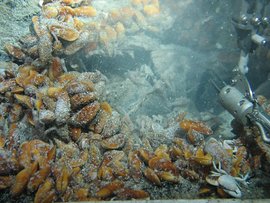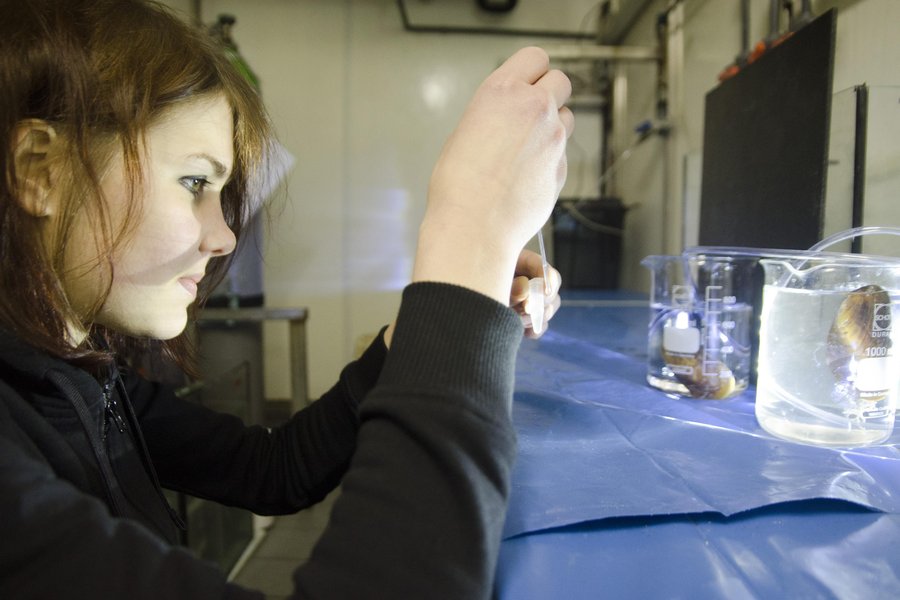- Press Office
- Phantoms in the Deep (and how they h...
Phantoms in the Deep (and how they help mussels get on)
“For most of the history of vent research, we’ve thought about these ecosystems as isolated island-like habitats”, Jillian Petersen from the MPI Bremen explains. “Our study questions this long-standing assumption: through population genetics and ocean current modeling, we showed that there must be undiscovered sites between the known vent fields to explain the dispersal of animals between vents.”
The oceanographers at GEOMAR had a tough job modeling ways the larvae can travel in the deep sea. “There exist virtually no data on current patterns of the deep sea”, says Arne Biastoch from GEOMAR. But after a lot of effort and adjusting, they managed to realistically simulate larval drift. The physical models of larval dispersal showed that it is extremely unlikely that larvae can disperse more than 150 kilometers. This was backed by a population genetic study of the mussels: “To explain the current genetic structure of mussel populations along the mid-ocean ridge in the Atlantic”, Petersen continues, “one has to assume many ‘stepping-stone’ habitats in between the known vents, which are hundreds of kilometers apart.”
“We call these habitats „phantom“ stepping stones as we do not know where they are and how they look like”, adds Thorsten Reusch from GEOMAR, senior author of the publication. This opens up the exciting possibility that there are many more hydrothermal vents out there to be discovered.
“In fact, we did find one such stepping stone with Bathymodiolus mussels on a previous cruise ”, Nicole Dubilier, director at the MPI Bremen, adds. “In 2010, we travelled to the Menez Gwen vent on the northern Mid-Atlantic Ridge and discovered a new hydrothermal vent at one thousand meters water depth, with chimneys as high as one meter and fluids with temperatures up to 300 degrees Celsius. The discovery was remarkable because the area in which it was found has been intensively studied during previous research cruises.”
“Investigating the dispersal of vent fauna is important, for example to understand the environmental impact of deep-sea mining”, Liz Sayavedra explains. If deep-sea mining was to be conducted around hydrothermal vent sites, which can be rich in massive sulfide, it is important to establish protected areas and corridors for the vent fauna. “Thus, it is crucial to know the time, distance, and generations that would take the larvae from one vent site to another.”
New methods for finding and mapping deep-sea vents using Autonomous Underwater Vehicles (AUVs) are starting to reveal the locations of many more of these stepping-stones. Early indications suggest that there might be hundreds of sites of diffuse flow, which can be more hospitable for animal life than the black smokers typically seen at hydrothermal vents. So far, it is not clear if all of these diffuse flow sites are colonized by animals. “But based on our results, I think there is a good chance we will also find vent animals such as Bathymodiolus at many of these”, says Petersen.
Written using material from the GEOMAR Press Release.
DOI: http://dx.doi.org/10.1016/j.cub.2016.06.062

Original publication
Dr. Corinna Breusing
cbreusing(at)geomar.de
Phone: +49 431 600 4538
Prof. Dr. Nicole Dubilier
ndubilie(at)mpi-bremen.de
Phone: +49 421 2028 932
or our press office
Dr. Fanni Aspetsberger
Dr. Manfred Schlösser
Phone: +49 421 2028 947 or 704
presse(at)mpi-bremen.de

